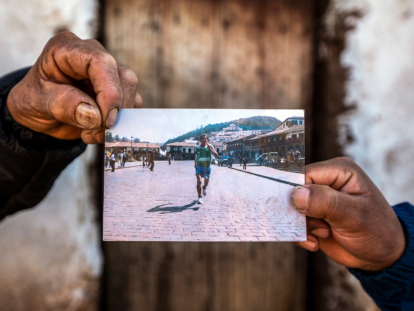Chasqui of the 21st Century
How one trail runner embodies his Inca heritage by running Peru’s sacred, ancient trails.
All photos by Diego del Río
At the top of the Inca’s Sacred Valley, one hour from the city of Cusco, Peru, is Racchi Ayllu. This Andean community sits above 12,000 feet, enveloped in white clouds and isolated from other towns. It holds an ancestral legacy that has always been essential for those who live there: its trails.
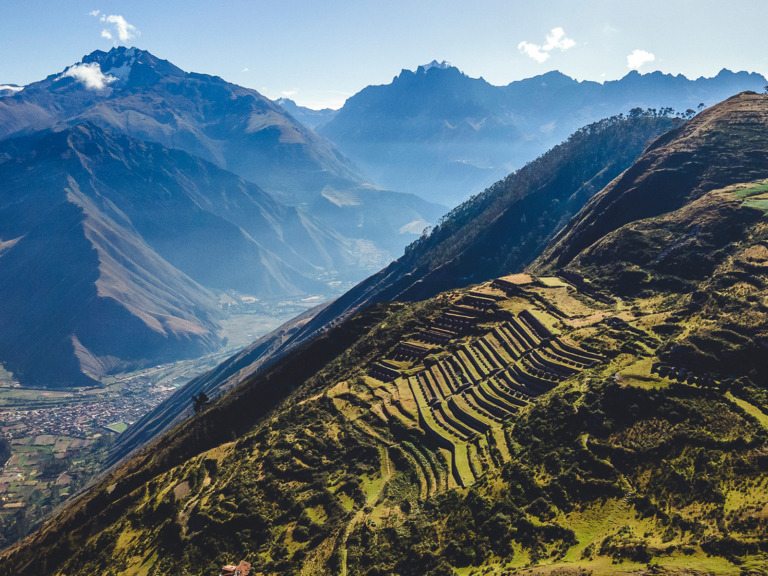
The Apus, or sacred mountains, that surround Racchi Ayllu are guardians of the Inca. The area’s trails are the veins of their empire, and its steep, terraced slopes show the resourcefulness with which the Incas approached their environment. Cusco, Peru.
These ancient routes, also known as Qhapaq Ñan (Great Inca Trail in Quechua), acted as a pillar of the Inca civilization, establishing a more developed communication network than those of other pre-Columbian cultures. These roads were used by a variety of people to travel by foot, connecting the Andes Mountains to the Pacific coast and bringing together different regions, ecosystems and products. It was through these trails that the Inca Empire was able to stay connected, solidifying its identity and power at the time.
That identity still lives in Andean cultures through traditions and spirituality. In Andean cosmovision, gods and beings of worship are earthly and can be experienced through the senses: the sun (Inti), the moon (Quilla) and the sacred mountains, better known as Apus. “Apu” in Quechua means “lord,” and it represents protective beings who watch over people, animals and even crops. Admiration for the Apus is a spectacle as the mountains change throughout the seasons. It’s a way to consider time in a more cyclical way. This veneration of the earth is said to anchor you in the present, unlike other belief systems that are based so much on the past. This is how life in the Andean mountains feels different.
It is in the mystical town of Racchi Ayllu, between natural balconies and prominent Apus, that Saturnino Ayma Bravo, 62, lives. “El Chasqui,” as he is known to his neighbors and colleagues, is a runner with a series of medals and records. Saturnino carries ancestral skills that allow him to travel the Inca trails as his ancestors did, and running is a practice that allows him to inhabit these spaces through movement, keeping his ancestors’ legacy alive.
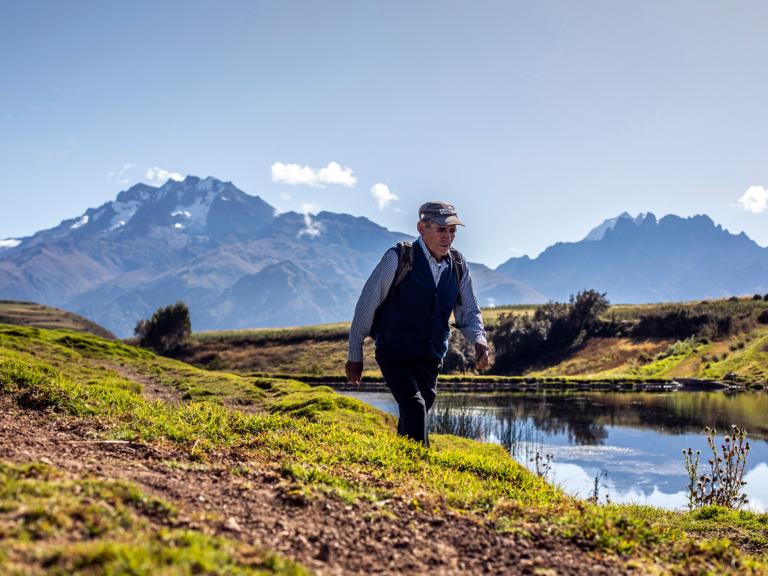
As part of his daily routine, Saturnino walks to his chacra, the small farm that provides a livelihood for his family. Behind him sits the Nevado Chicón—protector of the Inca’s Sacred Valley—and to his right is the water reserve that irrigates the crops for the entire community. Racchi Ayllu, Cusco, Peru.
In Quechua, chasqui means “the one who gives and receives.” In the time of the Incas, this title was used for messengers of the Empire who carried key information to different towns or strongholds. These runners covered the Qhapaq Ñan extremely quickly. The chasquis were literally the social network of the Inca Empire, but not everyone could achieve this title.
Within the Empire, only the most suitable were chosen to fulfil certain roles: farmer, rancher, weaver and, of course, chasqui. “The chasquis were quite important characters in the Inca era,” says Kenedy, Saturnino’s son. “They ran in relays, locating themselves in strategic spots known as tambos, and thus the messages quickly reached their destination.”
To become an official messenger of the Empire, there were many requirements besides being in good physical health. Chasquis also had to have a sharp memory for delivering information, a good sense of location and knowledge of the geography. Anyone who has walked in the Andes knows that breathing can become difficult and that it is necessary to maintain an adequate rhythm. Running there is not easy, and Saturnino knows it well.
He never thought he could make a living from running. His devotion to it began at 40, though running long distances in a short amount of time had always been part of his life. He was born and raised in Racchi Ayllu, and when he was growing up, the town had no school or paved roads. To get to class every morning, Saturnino and his friends had to run 5 kilometers (around 3 miles) down the Qhapaq Ñan to the community of Huayllabamba, which sits at almost 9,500 feet. This is the reality for many who live in the Andes. He remembers they did it in 10 minutes, around the same time that it takes many mountain bikers today. “We washed our faces in the river, took off our sandals and went into the classroom. Maybe that’s where my running story began,” he reflects.
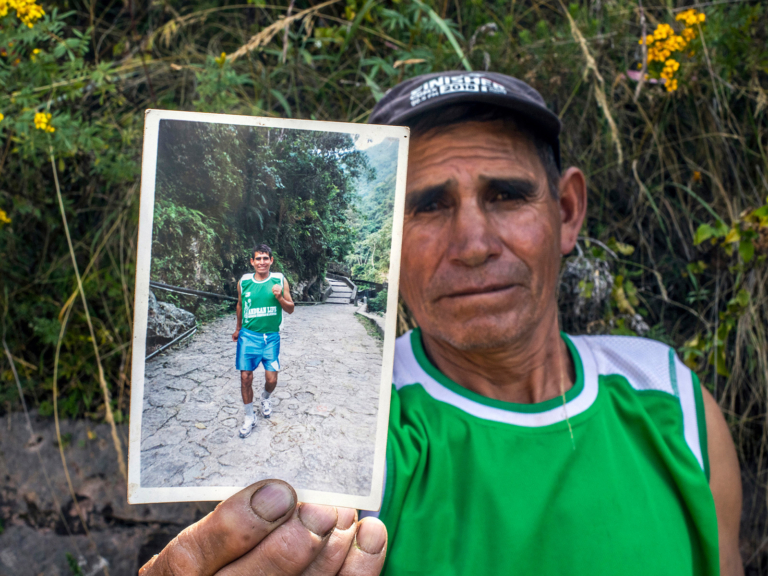
Having discovered the passion for running after the age of 40, Saturnino has always been proud to represent his community and his ancestors’ legacy. Machu Picchu, Perú.
Time passed and Saturnino’s legs became the driving force behind his work. Living in the countryside, daily training always accompanied him, even if it wasn’t intentional, thanks to chores on the farm. He’d often be told, “Saturnino, go down to the cornfield,” and he’d run 5 km. Later it would be, “Saturnino, collect the cattle.” That would be another 7 km. Traveling the Inca routes was always part of his daily life, and it imprinted on him the wisdom and technique of his ancestors. When he was older, he got married, had four children and dedicated himself to the farm like the rest of his community members—until one day a bet between friends opened a new door for him.
“We have to run, everybody is running,” a friend told Saturnino in January of 2001, encouraging him to run the community’s annual marathon. Saturnino, a bit older than the others and a little unprepared, hesitated at first but finally gave in. He won the competition. This experience and the connection he felt with the sport filled him with life. From then on, more opportunities started to appear: a 10K race in the Cruz Pata community, a race in Urubamba alongside some of the most renowned long-distance runners in the region, and the Pisac to Urubamba marathon. He consistently placed in the top five. His potential shone brighter as he approached the race that changed his life and earned him his nickname: the 2003 Inca Trail Marathon.
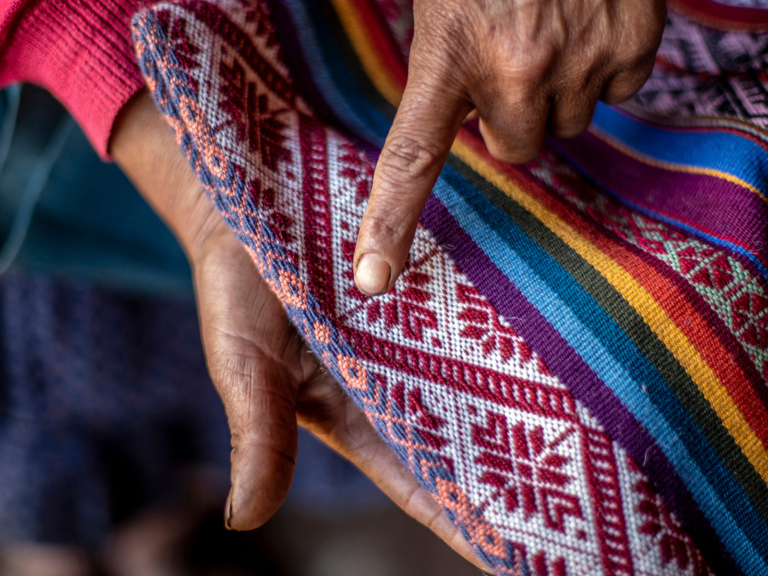
Although the Incas did not develop a formal written language, the pallay (iconography) of their textiles preserves stories of the empire. Susana Willca shows the representation of a ñan (trail) in her embroidery. Just as Saturnino does when walking the trails, women like Susana keep culture alive through their weaving.
At that time, this race still took place on the emblematic Andean route, and the challenge strongly appealed to Saturnino. The 24-mile course—normally done in four days on foot, reaching over 13,700 feet above sea level—was expected to take less than 10 hours. This trail goes through various altitudinal floors and multiple different ecosystems and has massive climbs at an already high altitude, making it one of the most difficult marathons in the world. Here, surrounded by professional athletes from all over the world and wearing sandals among so many running shoes, Saturnino made his entrance, carrying the confidence instilled in him by centuries of experience on these lands inherited from his ancestors.

Saturnino’s sandals, also called yanques or chanclas. This kind of footwear is common among Peruvian farmers. El Chasqui has proudly worn them on his small farm, to run and when he worked as a porter on the Inca Trail. They’re more comfortable, he says, because they’re easier to get out of the mud and dirt when conditions are rough.
The race began after a small breakfast in Corihuayrachina, in the Machu Picchu district, where the sacred stronghold of the same name is located. In the first section, Saturnino was in fifth place. Not letting this discourage him, he carried on at a steady pace until the climbing began. When he reached the Warmiwañusca (the Quechua name for “dead woman”), the highest point of the Inca Trail, the race took a turn. “I began to pass one participant after the other … and only five of us reached the last summit,” he said. Only three arrived at Pacaymayo, and halfway through the race, there were only two participants left. With only one runner ahead, victory was close, but he still had to endure an important part of the way.
On the descent to Wiñay Wayna, an imposing archaeological site on the way to Machu Picchu, Saturnino almost gave up. His legs and chest were shaking, and he was short of breath. He only had coca leaves with him, which the ancestral chasquis used to remedy hunger, thirst and loss of concentration. He could hardly muster the courage to continue to the final stretch. But he preserved, and Saturnino Ayma, at 42 years old, won the marathon with an impressive time of 4 hours and 26 minutes.
“Luck accompanied me until I broke the tape,” he explains excitedly. “Having won, like never before in my life, gives me pride.”
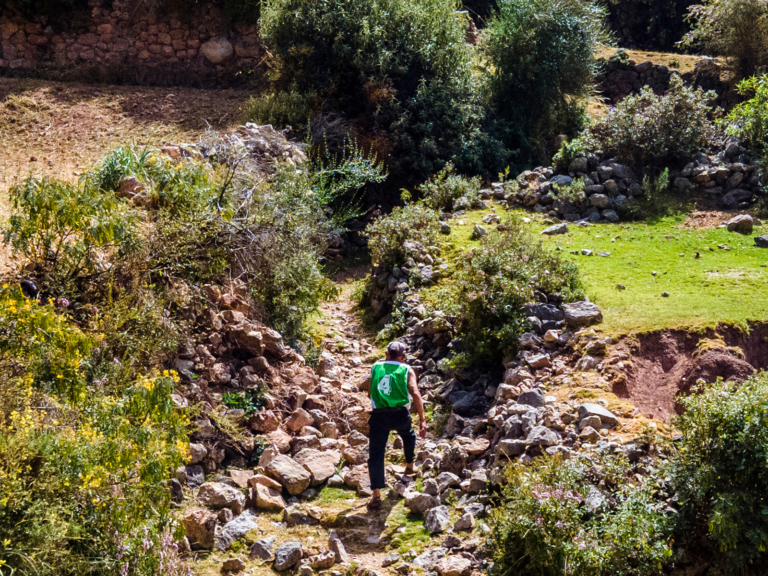
Saturnino travels part of the Inca Trail that connects Racchi Ayllu with Huayllabamba. The Inca roads are slowly being abandoned due to their natural construction and lack of maintenance; they now face the threat of disappearing altogether.
It was because of this race that Saturnino earned his nickname El Chasqui. Although he is not a messenger of the Inca Empire, modern chasquis are high-mountain runners who continue to use the Qhapaq Ñan routes to get around, whether for training or in their day-to-day activities. The most tangible legacies of the Incas are transmitted through the architecture and engineering feats that still remain. The cultivation terraces, irrigation canals and, of course, the trail networks are evidence of a living culture that carries an ancestral legacy. And traveling those paths is part of the same heritage.
El Chasqui became a legend on the Inca Trail. Winning the race led him to work as a porter on the route, and he remembers proudly how guides and tourists approached him asking for a photo and wanted to hear about the origin of the chasquis, from the mouth of a present-day chasqui.
Today, Saturnino keeps running to reach the small patches of land he cultivates. Feeding and taking care of his family is what motivates him now. Every day, when he goes down to look after his cornfield, he continues touring the Qhapaq Ñan, still amazed by the engineering of these Inca roads—the curvature of its walls, the paving of its floors and even the caves where his ancestors spent their nights. “The stones deserve the same respect that a father deserves,” he says with enthusiasm.
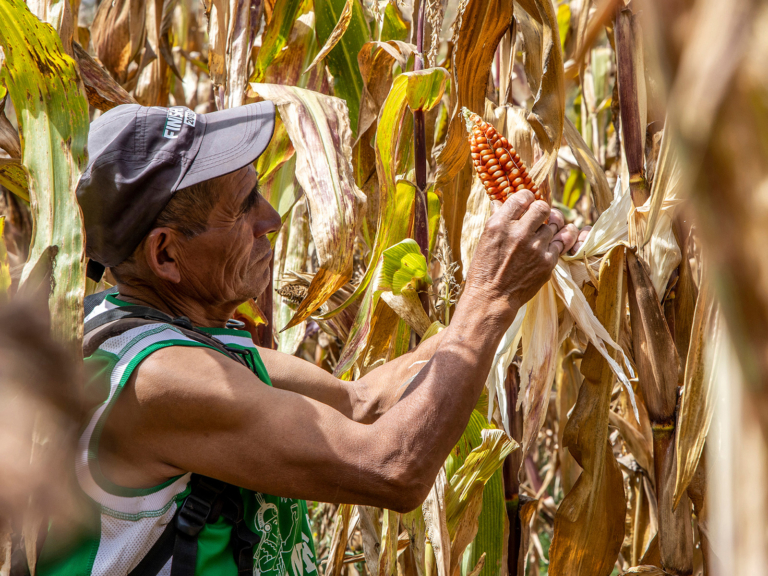
Located at the fork of an Inca trail and a colonial one, Saturnino’s corn farm reveals the last harvest of the season.
These roads are a symbol that are respected and adored. Living with them and using them revives the past and honors the steps that the ancient Incas took on them. They are not ruins for contemplation but rather a portal that brings the past to the present, anchoring itself in earthly spirituality. Keeping these trails means continuing to paying tribute to the physical work of the Incas, and it is up to this generation to maintain them for those that follow. “When I walk through the Qhapaq Ñan, what I feel is peace,” says Saturnino.
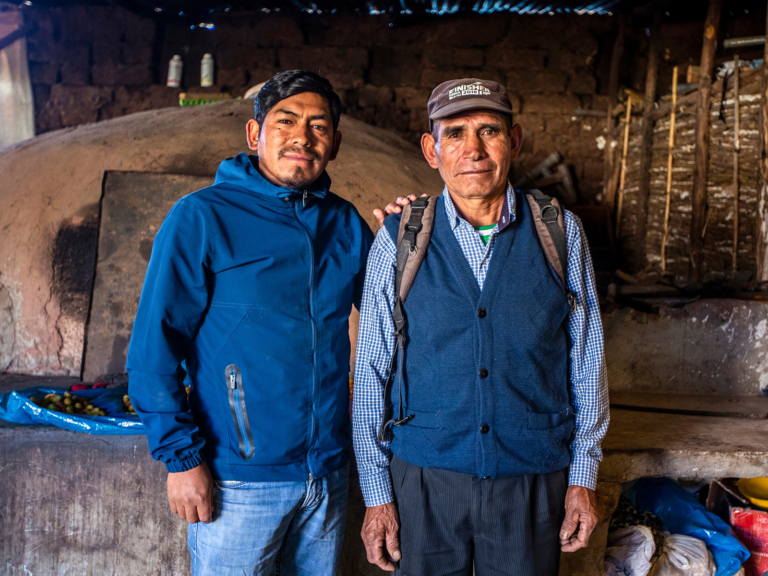
Father and son pose in front of the Ayma family’s traditional clay oven. Both men are concerned about the changes that modern life brings to their environment and know the importance of keeping their culture alive.
Yet, despite the uniqueness of these imposing landscapes and ancient engineering, the reality of Racchi Ayllu is about to change. The Chinchero International Airport is being built near the community, and it will attract even more tourists to the Sacred Valley and its main tourist destination, Machu Picchu. Colorful hills are being flattened for construction, endangering the lifestyle of this place that has endured for so long.
The Ayma family worries. Although the construction of this airport generates jobs, they believe that in the long term, the illusion of prosperity could fall, leaving them disconnected from the lifestyle that has sustained them for so long.
This is partly why they work so hard to create spaces for traditions to remain alive. Every year on the fourth of January, the anniversary of the Racchi Ayllu community, El Chasqui’s children, nephews and extended family participate in the traditional marathon where his running career began. Saturnino serves as a coach, offering advice on the route and tips to keep them from running out of breath, and reminding them that their steps will follow those of their ancestors. He knows that his role is to lead by example and show the importance of traveling these trails. An Inca legacy passes through Saturnino and is handed down to the next generations of runners.
